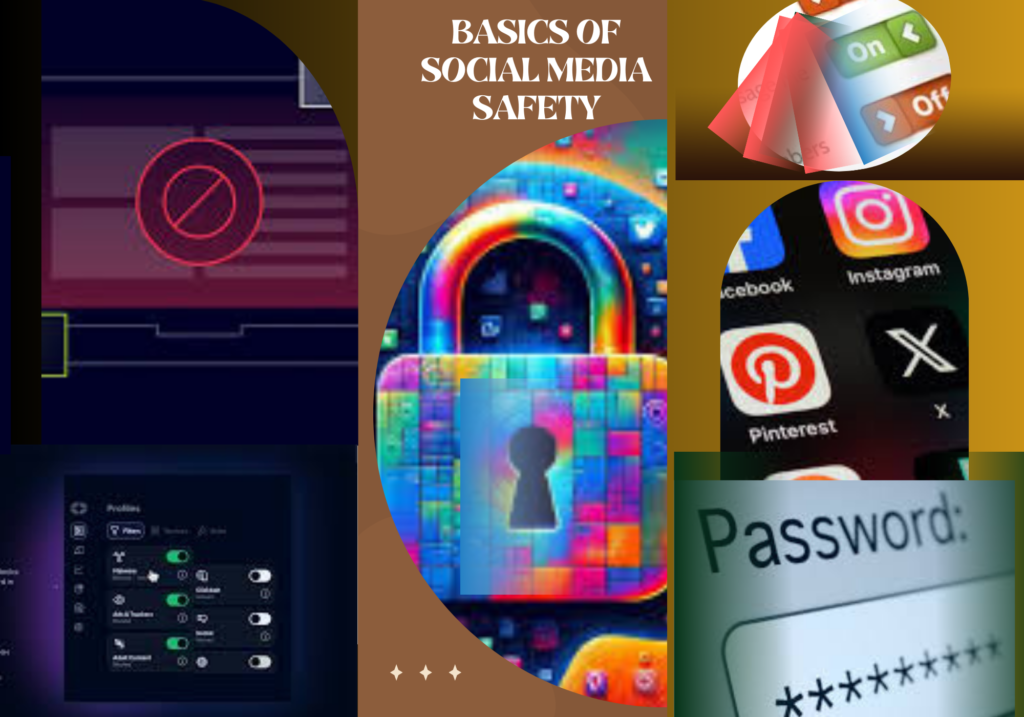Table of Contents
Toggle
Why is necessary social media safety?
How can sharing too much on social media affect your privacy?
What is an online footprint?
What are safety tools on social media platforms?
How can you report harmful content?
How can you filter content on your social media feed?
What does it mean to have a private account on social media?
How can location sharing put you at risk?
9. What should you do before sharing your location online?
10. Why is public Wi-Fi risky for social media use?
11. How can a VPN help protect your privacy online?
12. How can you set boundaries with friends about sharing on social media?
13. Why should you be careful with links on social media?
14. How can you create a strong password for social media?
Sharing on Social Media: Your Choice, Their Control
Social media is a platform to connect, share, and express yourself. What you choose to share is entirely up to you, but it’s important to understand that once shared, your information might be used in ways you cannot control. This guide is a comprehensive look at how to keep yourself safe while enjoying the benefits of social media.
Understanding the Basics of Social Media Safety:
When you post, comment, or share something on social media, you are creating an online footprint. This footprint can be viewed, copied, or misused by others. To minimise risks, start by understanding your platform’s safety tools.
What Are Safety Tools?
- Reporting Tools: These allow you to report content or users that violate platform guidelines.
- Blocking Tools: You can block users to prevent them from interacting with your profile or posts.
- Filtering Tools: These let you customise what you see on your feed and who can contact you.
How to Report, Block, and Filter Content?
Reporting Harmful Content:
If you see harmful, abusive, or inappropriate content:
- Look for the “Report” option, often found under the post or in a menu.
- Follow the steps provided by the platform to submit your report.
- Reports are usually anonymous, so the person won’t know you flagged their content.
Blocking Users:
Blocking someone is a quick way to protect yourself. Once blocked:
- They cannot view your profile.
- They won’t be able to message or interact with you.
- You won’t see their content anymore.
Filtering Your Feed:
You can filter what content appears on your social media. For example:
- Hide posts with certain keywords.
- Mute accounts without unfollowing them.
- Adjust settings to prioritise content from people you trust.
Adjusting Your Privacy Settings:
Each platform offers privacy settings to control what others see. These settings let you decide:
- Who can view your posts (e.g., friends, followers, or the public).
- Whether your profile is discoverable in searches.
- If others can tag you in posts.
Non-Traditional Platforms:
Don’t forget about privacy on less obvious platforms like:
- Venmo: Ensure transactions are private.
- Spotify: Hide your listening activity.
Privacy Guides for Major Platforms:
Each social media platform has specific privacy settings. Learn how to adjust them here:
- Twitter: Control who can see your tweets and interact with you.
- Instagram: Make your account private or restrict users.
- Facebook: Adjust your profile visibility and tag approval.
- Pinterest: Manage followers and hide specific boards.
- Snapchat: Limit who can send you snaps or see your stories.
- Tumblr: Customise blog visibility.
- LinkedIn: Control who can view your connections and profile details.
Pause Before You Post:
Questions to Ask Yourself Before Posting:
- Would I feel comfortable if this was shared publicly?
- Does this post include personal details like my location, routine, or sensitive information?
- Could someone misuse this post if it was saved or screenshot?
Remember:
Even deleted posts might remain accessible through screenshots or platform records.
Turn Off Location Sharing:
Many social media apps request access to your location, but this isn’t always necessary.
Risks of Location Sharing:
- Revealing your exact location can put you at risk of unwanted attention.
- Geotagged posts might allow strangers to track your routine.
Tips for Location Safety:
- Disable location access for apps that don’t require it.
- Only share your location after you’ve left a place.
- Regularly review your app permissions.
Use Private Internet Connections:
Public Wi-Fi can be convenient, but it’s often unsafe for sensitive activities.
Dangers of Public Wi-Fi:
- Hackers can intercept your data.
- Login details may be exposed to others.
Safer Alternatives:
- Use your mobile data instead.
- Think about getting a Virtual Private Network (VPN) to boost your internet safety.
- Stick to trusted private networks.
Set Boundaries with Friends:
Sometimes, the biggest risk to your privacy comes from well-meaning friends who overshare.
How to Talk to Friends:
- Be clear about what you’re comfortable sharing.
- Ask them to avoid posting personal details or photos of you without permission.
Tools to Help Manage Posts About You:
- On platforms like Facebook, enable tag review so you can approve posts before they appear on your profile.
Report Harassment and Save Evidence:
If you’re a victim of online harassment, take action immediately.
Steps to Handle Harassment:
- Block the user to stop further contact.
- Report the behaviour using the platform’s tools.
- Take screenshots of messages or posts as evidence.
Keeping Records:
Platforms like Facebook allow you to download a copy of your account data, which can be useful for evidence.
Be Careful with Links:
Clicking unknown links can expose your device to malware or phishing attempts.
How to Avoid Suspicious Links?
- Don’t click links from unknown sources.
- Double-check with friends if they’ve sent you a link unexpectedly.
- Use anti-virus software to scan links and attachments.
Use Strong Passwords:
A weak password makes it easy for hackers to access your account.
Tips for Strong Passwords:
- Use a mix of letters, numbers, and symbols.
- Avoid using obvious words or dates, like “password123” or your birthday.
- Change passwords regularly.
Secure Storage:
Consider using a password manager to safely store your login details.
Regular Privacy Check-ups:
Social media platforms frequently update their settings and policies.
Why Regular Reviews Are Important?
- New features might expose more of your information.
- Policy changes could affect your privacy preferences.
Set a Reminder:
Every three to six months, revisit your privacy settings to ensure they match your current needs.
Conclusion: Staying Safe on Social Media
Social media helps us stay connected, share moments, and express ourselves. However, it’s important to be cautious about what you share, as you might lose control of your information once it’s online.
Simple actions like adjusting privacy settings, thinking before posting, limiting location sharing, and using secure connections can make a big difference in keeping you safe. Talk to friends about boundaries, stay alert to potential risks, and handle issues like harassment confidently by using platform tools.
By being mindful and reviewing your settings regularly, you can enjoy social media while protecting your privacy and security. Stay safe and in control of your digital life!
FAQS:
1. Why is it important to control what you share on social media?
Sharing too much can expose your personal information, which might be used by others in ways you cannot control.
2. How can you adjust your privacy on social media?
Each platform has privacy settings. You can decide who sees your posts, who can interact with you, and if your profile is searchable.
3. What should you do before posting online?
Pause and ask yourself if you’re okay with everyone seeing your post forever, even if it includes personal or sensitive details.
4. Why should you turn off location sharing?
Sharing your location can reveal your whereabouts and routine, putting your safety at risk. It’s better to disable it or share locations after you leave a place.
5. How can public Wi-Fi be risky for social media use?
Hackers can intercept your data on public Wi-Fi. It’s safer to use mobile data, private networks, or a Virtual Private Network (VPN).
6. What steps can you take if someone harasses you online?
Block the person, report their behaviour to the platform, and save screenshots as evidence in case you need it later.
7. How often should you review your social media privacy settings?
Check your settings every 3-6 months to keep up with changes in platform policies and features.
